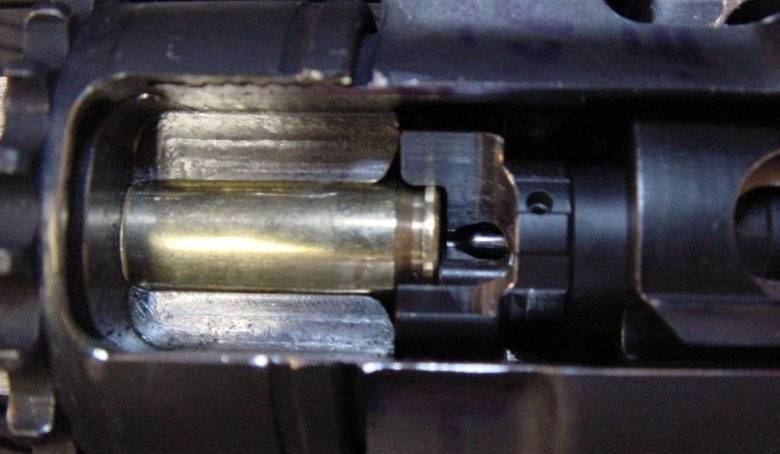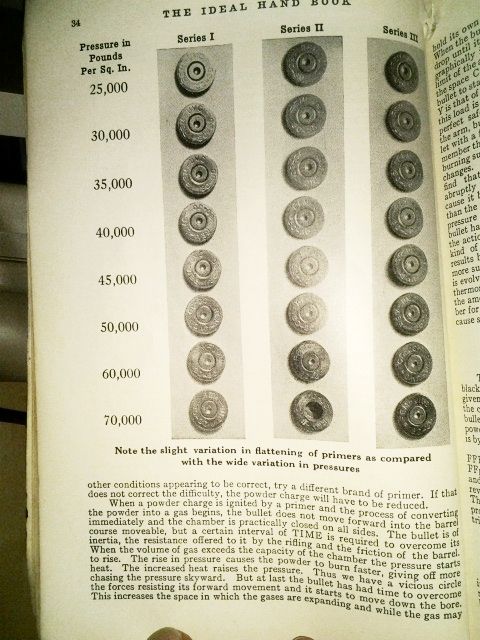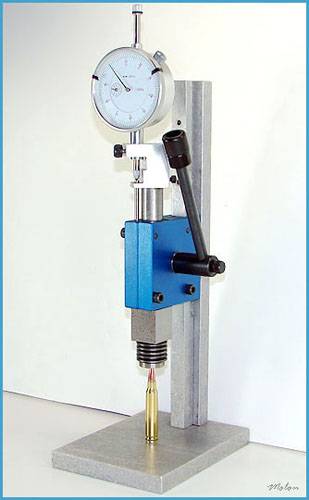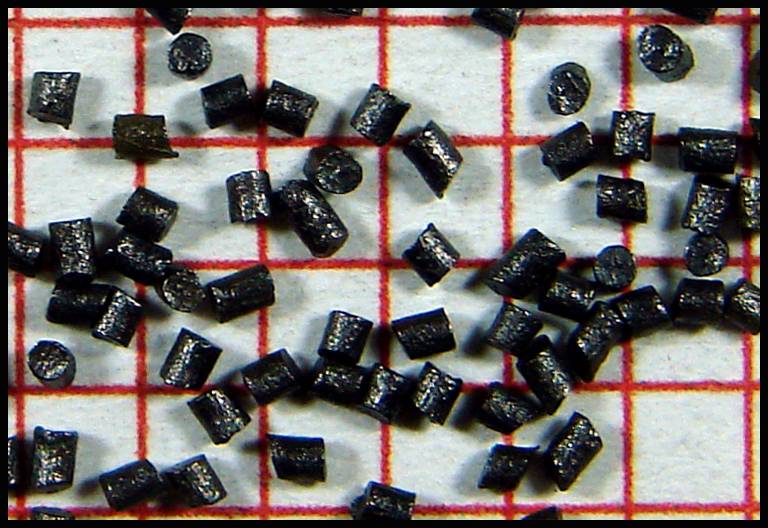Safety Warning for Berger 77 grain OTM: Pressure Testing Update
This is a safety warning pertaining to Berger’s factory loaded ammunition.
Berger 223 Remington
77 grain OTM Tactical
Part # 65-23030
Lot # P002745-1
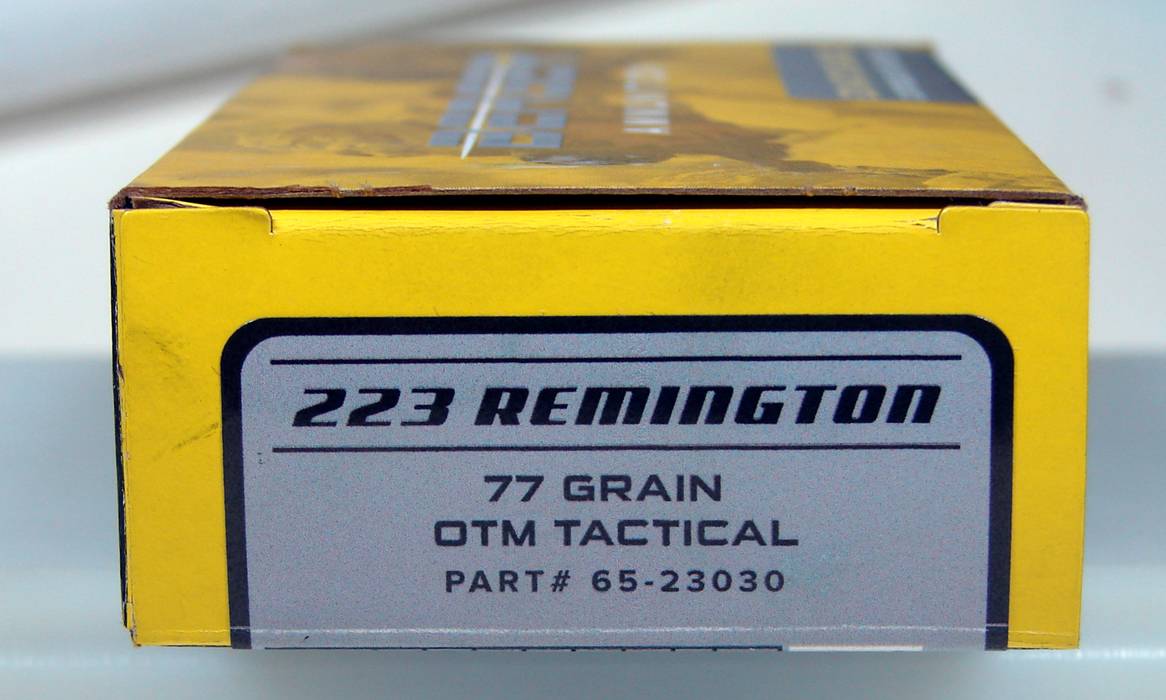
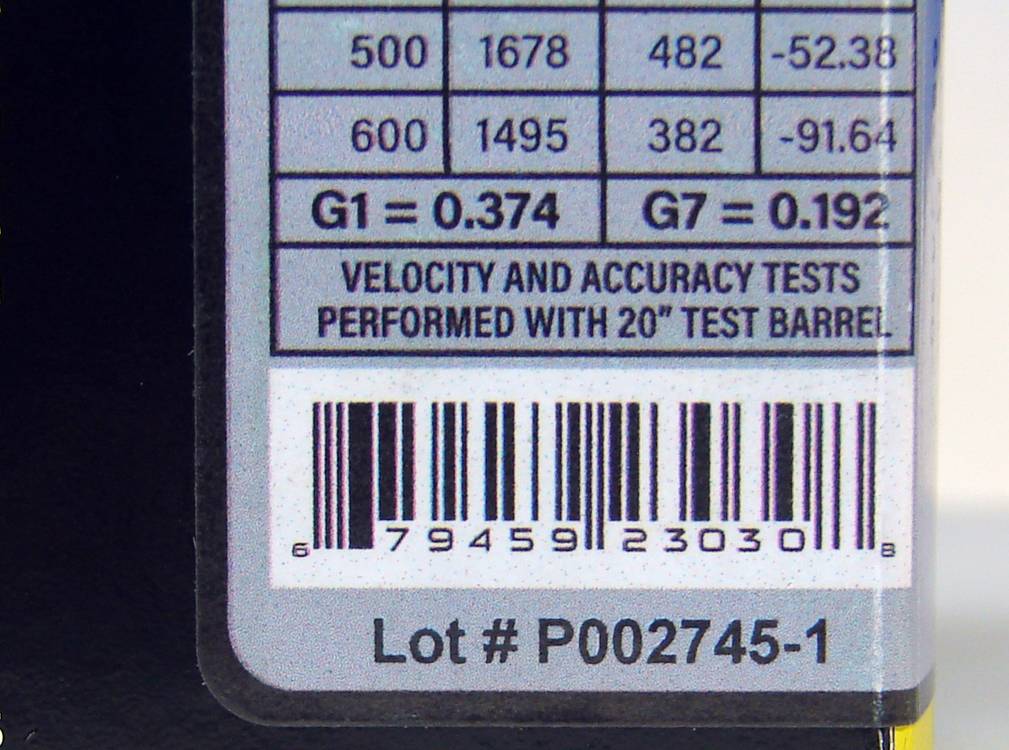
While firing this ammunition from one of my Krieger barreled, semi-automatic, precision AR-15s, I experienced an uncharacteristic amount of recoil and muzzle blast. This occurred with the second round fired from the magazine and there were two bullet holes in the target, so there was no type of bore obstruction involved. (This AR-15 has functioned flawlessly for over one thousand rounds and has produced ½ MOA 10-shot groups at 100 yards.)
The action failed to cycle after firing this second round from the magazine and the trigger was dead. No amount pulling/pounding on the charging handle was able to free-up the bolt carrier group. As stated above, there were two bullet holes in the target so there was no type of bore instruction involved.
At home, I had to use a mallet and a Delrin rod to pound the bolt, carrier and case out of the barrel extension/upper receiver. Prior to pounding out the bolt carrier group, I took a quick look in the bore with a cheap borescope. It was clearly visible that the brass case (Lapua) was still tightly sealed to the walls of the chamber.
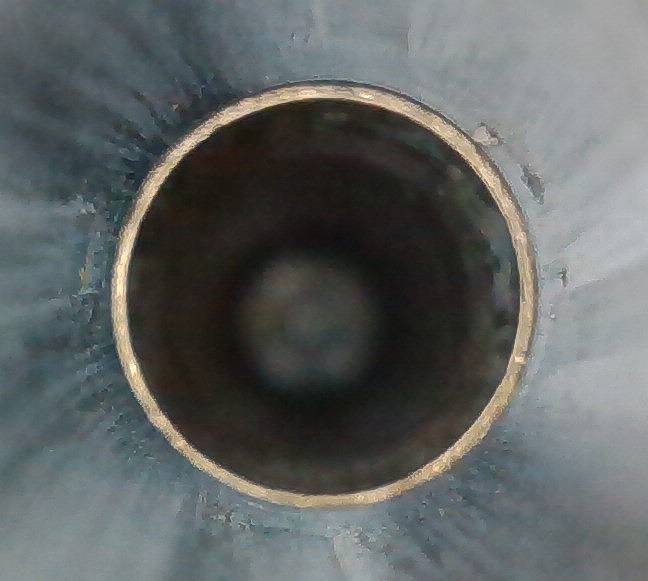
Upon examining the spent case, it was clearly visible that the primer pocket was greatly expanded and there was a large amount ejector and extractor brass-flow. The primer fell out of the bolt face when the case was removed with the pounding-out of the bolt carrier group.
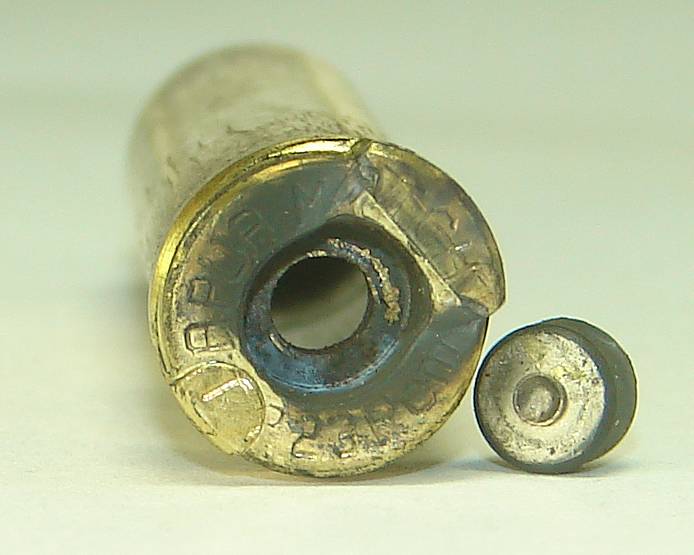
The was a large “belt” of expanded brass just above the extractor groove. This belt had a diameter of 0.414” at the at the broadest section. The case was split on either side of the extractor brass flow. The case rim was split at the ejector brass flow.
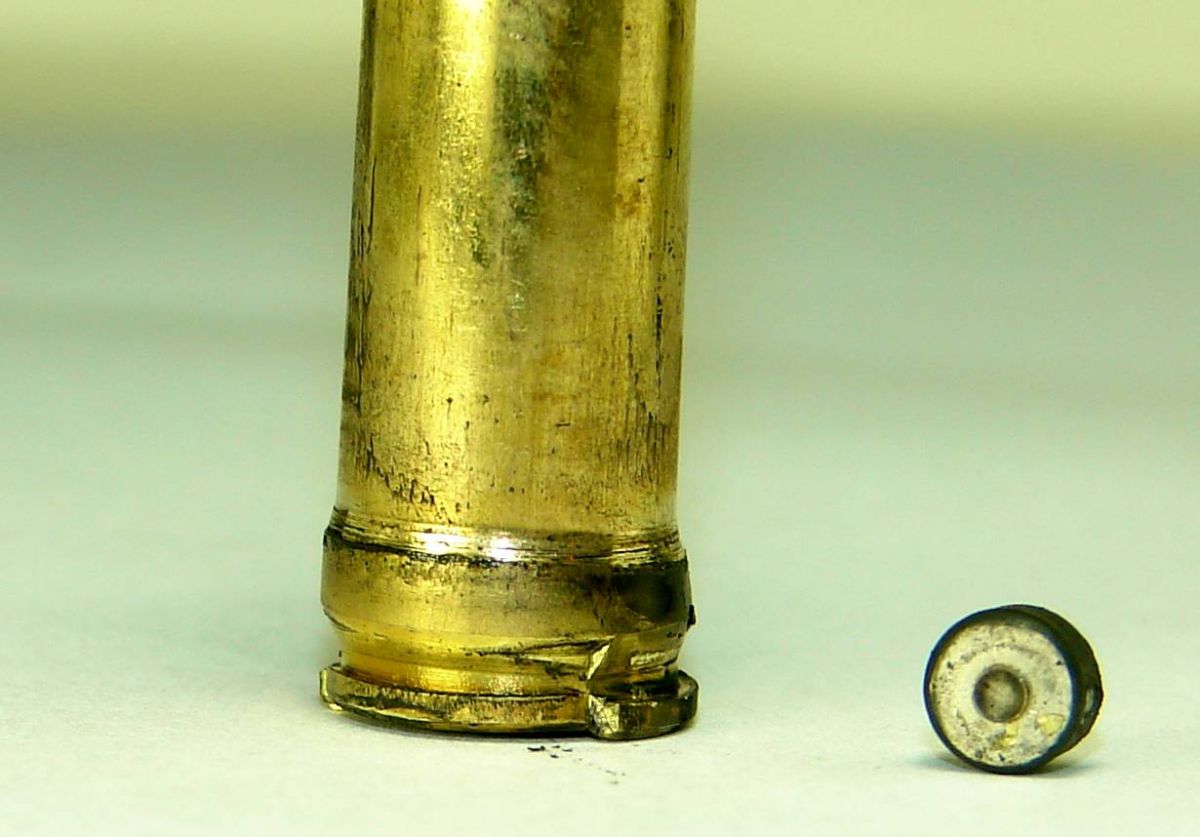
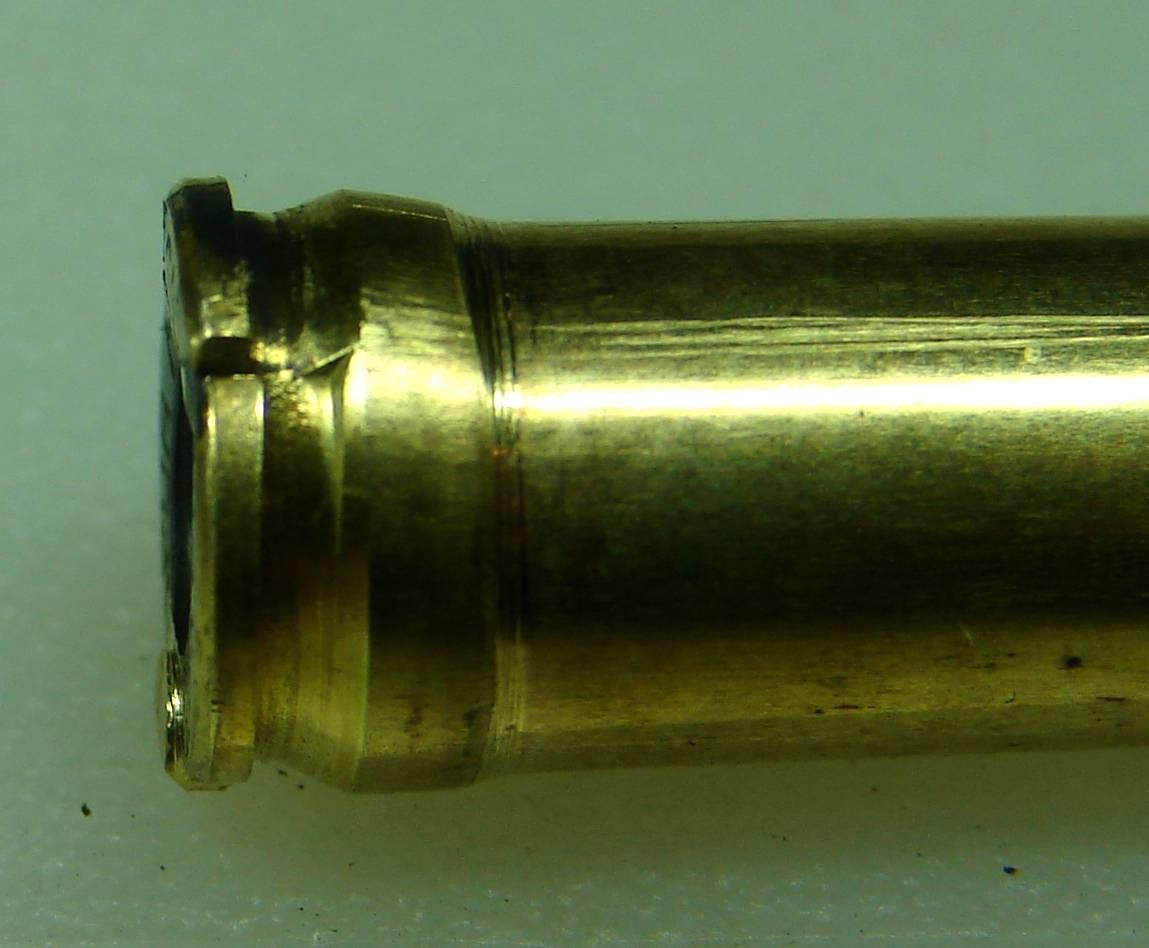
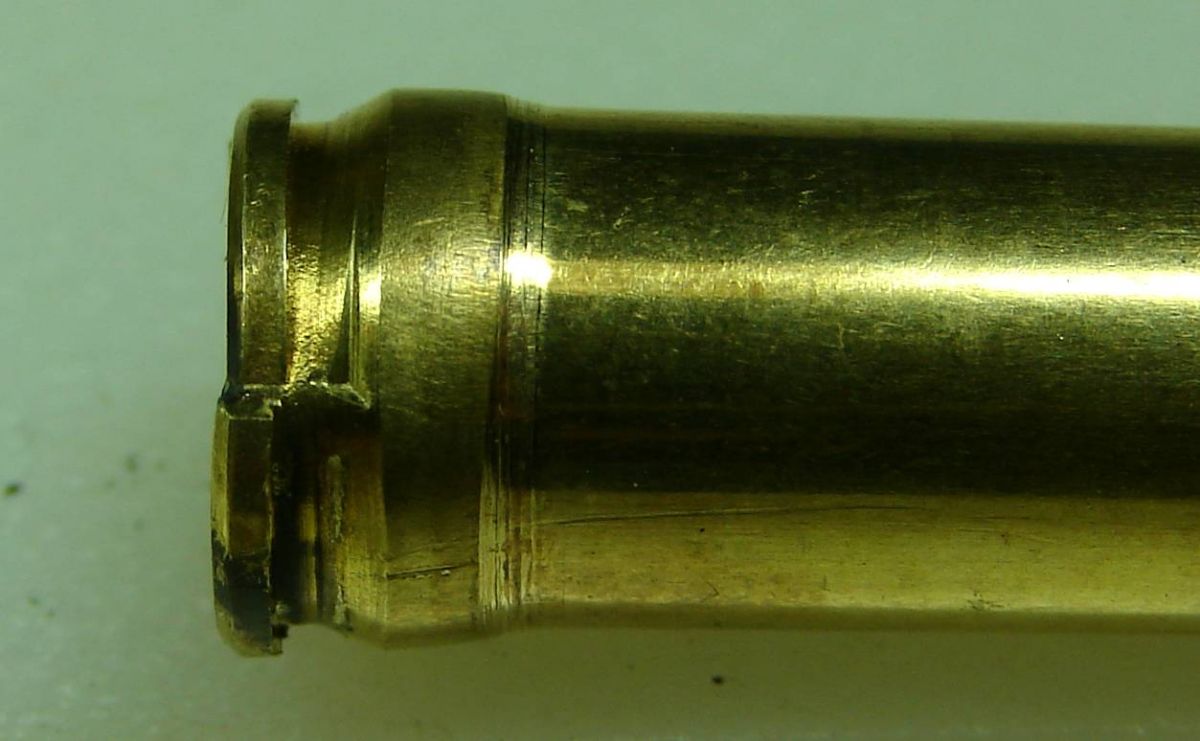
I have not yet conducted a damage assessment of my AR15. A link to this thread has been sent to Berger and I’ll post their reply when I receive it. Until such time, I urge anyone who has also purchased this ammunition not to use it.
-----------------------------------------------------------------------------------------------------------------------------
This Krieger barrel has a 223 Remington chamber with a 1:9" twist. This barrel was purchased directly from Krieger Barrels, Inc. and was chambered by them. I've fired over a thousand trouble-free rounds through this barrel. The box label for this Berger ammunition clearly states that this is 223 Remington ammunition.
Using a bullet pulled from this lot of ammunition, I determined the cartridge overall length that would be necessary for the bullet to be seated to the lands of this barrel. That distance was 2.322" and since the factory loaded ammunition was loaded to magazine length, the bullet was nowhere near the lands of my barrel.
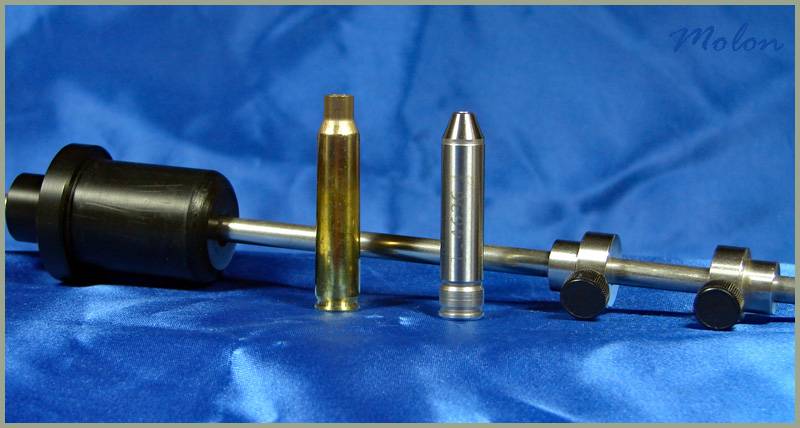
Shortly before shooting this Berger factory loaded ammunition, I fired a 10-shot group of factory loaded Sierra Prairie Enemy 55 grain BlitzKings. That group had an extreme spread of 0.72 MOA.
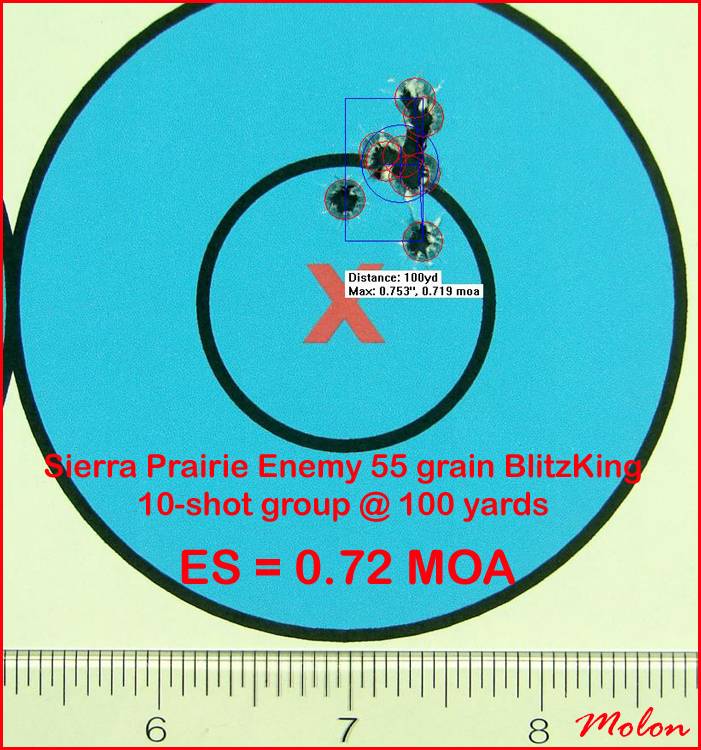
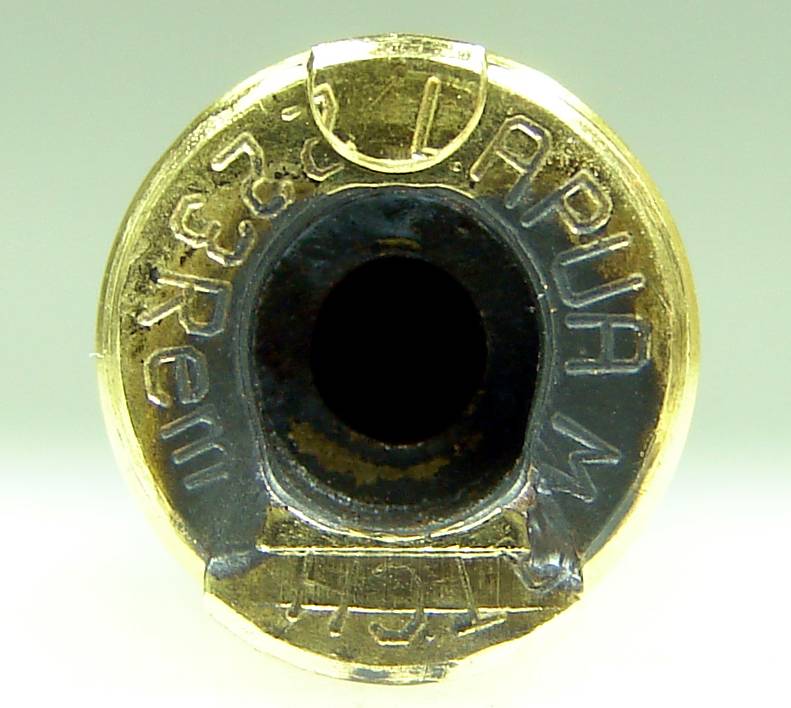
The blown case has a weight of 99.0 grains. The neck diameter of this case is 0.254”. The diameter of the “belt” above the extractor groove is 0.414” at the broadest section.
The diameter of the case rim across the extractor and ejector brass flow is 0.423” and the diameter of the case rim rotated to 90 degrees of that position is 0.382”. The primer pocket has a diameter of approximately 0.222” at the broadest section.
I pulled-down 20 of the unfired cartridges from this lot of ammunition. Here’s the compiled data.
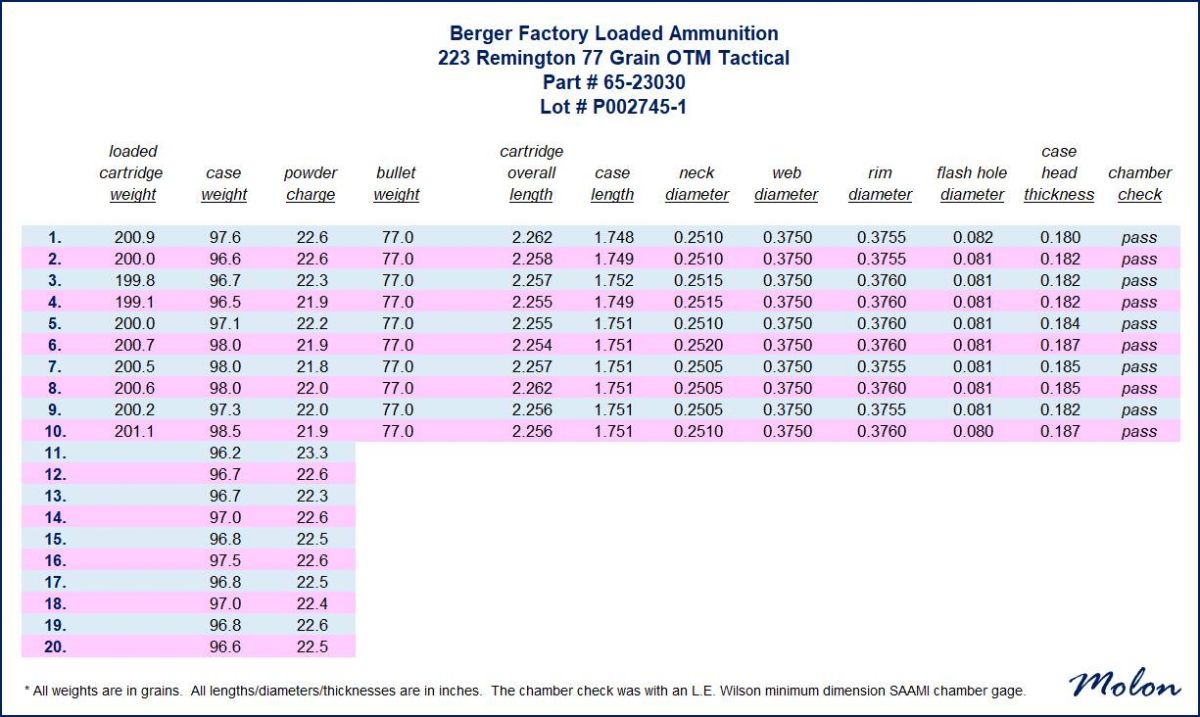
You can see a larger view of the above data sheet here. (or just click on the pic above.)
Pulled-down powder from this Berger ammunition.
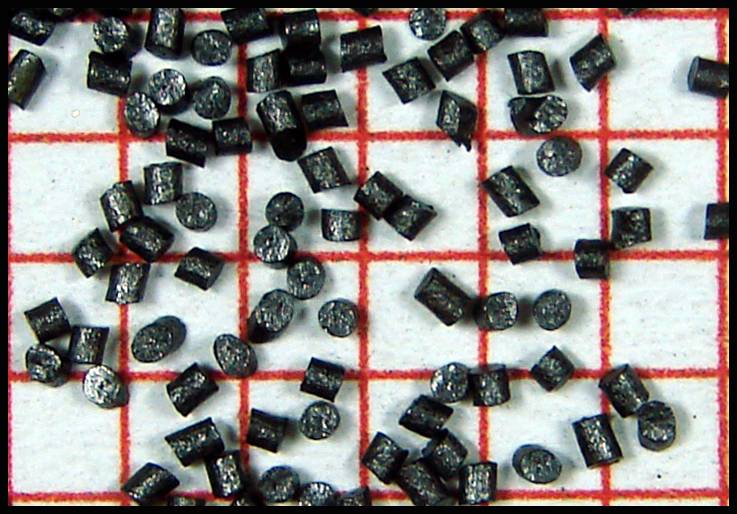
Pulled-down powder charge weights . . .

I pulled-down a couple more rounds after compiling the above data and found a round with a charge of 23.6 grains. The puts the powder charge variation at 1.8 grains.

28.6 grains of this pulled-down powder filled a randomly selected pulled-down case to the case mouth. The longest cartridge overall length that I measured from this lot of factory loaded ammunition was 2.262". I was able to load 26.0 grains of the pulled-down powder into a pulled-down case and seat a pulled-down bullet to a cartridge overall length of 2.262".
This ammunition is a heavily compressed load, so bullet set-back is highly improbable. Since it was a compressed load, I was unable to use my custom K&M compression gauge to obtain an accurate measure of neck tension, however, it required quite a bit of force to pull the bullets from the cases using a press-mounted, collet bullet-puller. Also, using the custom K&M compression gauge, I applied 90 pounds of force to one of the factory-loaded cartridges that had a cartridge overall length of 2.253". After applying the 90 pounds of force, I again measured the COAL. It was still 2.253".
Pulled-down case weights . . .

The case weights past the plus one standard deviation are the heaviest Lapua Match cases that I've ever seen. (Legacy"standard" Lapua cases did weigh more.)
Berger did eventually issue a "safety notice" for this ammo, but not until after I informed them that I was not going to return the defective ammo. That was four weeks after I informed them of the issue. The safety notice stated that this ammunition "may cause function/ignition issues with AR-style gas operating platforms" and that "bolt action rifles are not affected".
---------------------------------------------------------------------------------------------------------------------------------------------------------
Pressure Testing Update
We’ll never know what the powder charge weight was for the factory loaded round of Berger 77 grain OTM ammunition that blew-out in my AR-15. We do know for a fact that the weight of the case that blew-out was 99.0 grains. We can also be fairly certain that the weight of the bullet in that round was 77.0 grains, since all of the bullets that I pulled-down from that same lot of ammunition weighed 77.0 grains. We also know that primers from pulled-down rounds in that lot of ammunition had a nominal weight of 3.7 grains.
In addition, we know that Berger’s abysmal quality control resulted in powder charges for the sample of rounds that I pulled-down to range from 21.8 grains to 23.6 grains for this so-called “match grade” ammunition. That’s a spread of 1.8 grains in the powder charge and it’s quite likely that a larger sample size would have detected an even greater spread.

The mean powder charge weight for the small sample that I weighed was 22.41 grains. The standard deviation was 0.447 grains. The mean powder charge weight plus three standard deviations was 23.75 grains.
The pressure testing was conducted in the ballistic lab of one of the leading ammunition manufacturers in the United States. A 24” SAAMI spec 223 Remington pressure and velocity test barrel was used with a PCB conformal pressure sensor. The system was calibrated with SAAMI reference ammunition and additionally the pressure sensor was calibrated to unfired Lapua cases pulled-down from the Berger ammunition.
The SAAMI specification for the maximum average pressure for the 223 Remington cartridge is 55,000 PSI. Ten rounds of the Berger factory loaded 77 grain OTM ammunition were fired from the 223 Remington pressure test barrel. Obviously, we don’t know what the powder charges were for those ten rounds.
You may remember that in the last email that I sent to Mr Praslick (the one that he didn’t even have the common courtesy to reply to) I stated that it would have taken a pressure of over 70,000 PSI to cause such deformities to the cartridge case when fired from an AR-15. The first shot fired from the pressure test barrel had a pressure of 77,919 PSI. Shot #8 had a pressure of 78,369 PSI. That’s 23,369 PSI higher than the SAAMI MAP specification for the 223 Remington cartridge.
The data for all ten shots is summarized in the table below. This data shows that Berger failed miserably in their due diligence in developing and manufacturing this load and releasing this dangerous product for sale to the public.
The data also makes it painfully obvious that this was not a “cycling” issue for semi-automatic AR-15s and that Berger’s safety notice (the one that they didn’t even issue until a month after I informed them of this safety issue and that they didn’t issue until after I had notified them that I was not going to be returning the defective ammunition to them) claiming that this ammunition “may cause function/ignition issues with AR-style gas operating platforms. Bolt action rifles are not affected” was just a whitewashing of their lack of transparency in this matter.
Aside from the huge safety issue with this ammunition, the velocities from the test barrel had an extreme spread of 221 FPS with a standard deviation of 74 FPS. That is beyond pathetic for so-called “match grade” ammunition that cost $1.60 per round.
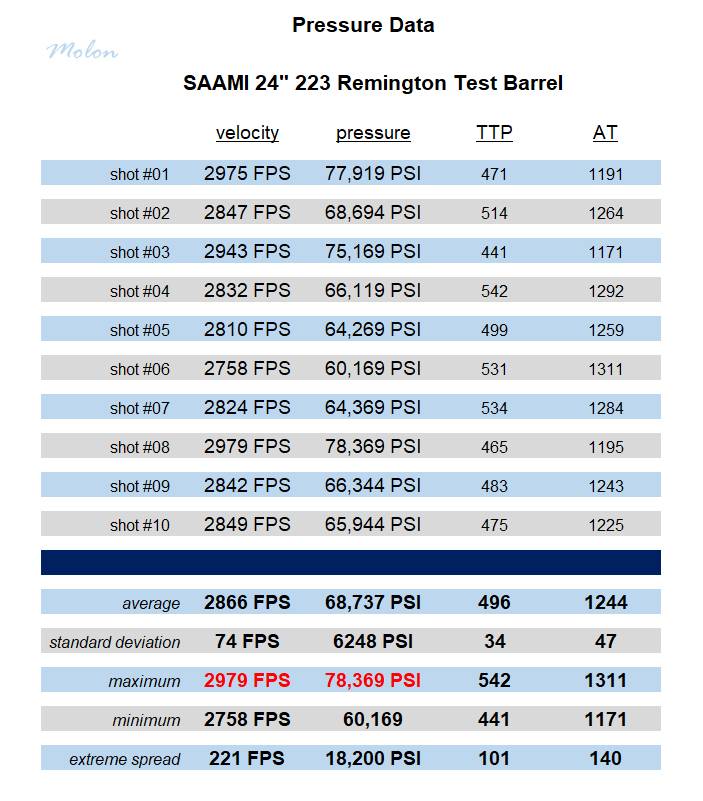
TTP = time to peak pressure
AT = time to the bullet exiting the muzzle
As I mentioned earlier, a powder charge weight of 23.6 grains was found in the small sample of rounds that I pulled-down and it’s likely that a heavier charge would have been found with a larger sample size. The average powder charge weight plus three standard deviations was 23.75 grains.
For additional testing I pulled-down several more rounds from this lot of the Berger factory loaded ammunition and re-charged those rounds with a powder charge weight of 23.7 grains of the pulled-down powder. The powder was dispensed using an RCBS Match Master powder dispenser. The Match Master dispenser has an advertised accuracy of 0.04 grains. The heaviest Lapua case (accounting for the weight of the primer) of these rounds weighed 97.0 grains.
I seated virgin Berger 77 grain OTM bullets (all of which weighed 77.0 grains) in the re-charged cases to a nominal COAL of 2.260” using a Forster Co-Ax press. Five of these re-charged rounds were fired from the same pressure test barrel described above.
Shot #2 had a pressure of 81,769 PSI. Shot #4 had a pressure of 83,544 PSI with a velocity of 3024 FPS. The results are summarized in the table below.
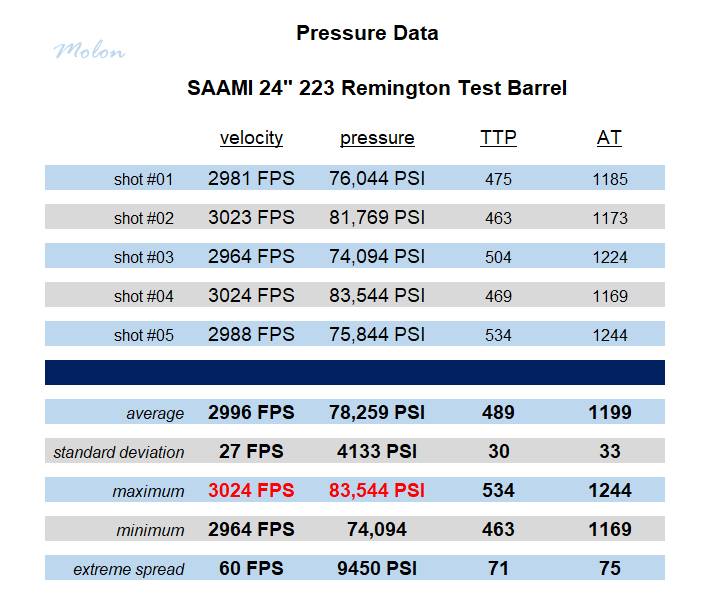
….
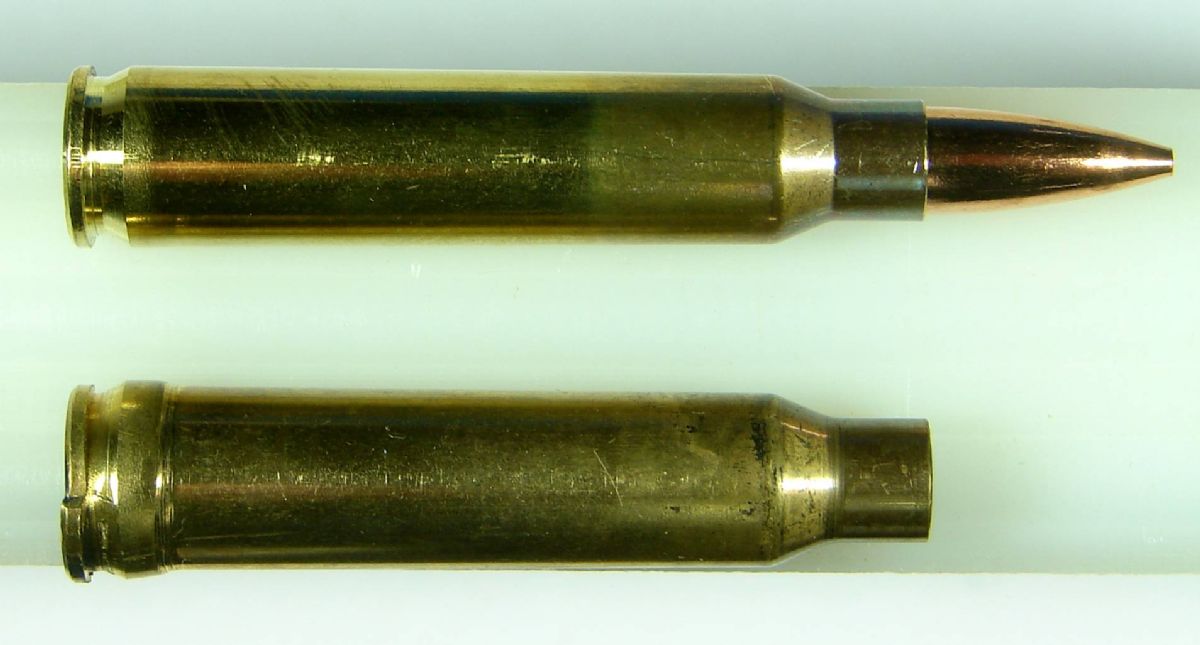
--------------------------------------------------------------------------------------------------------------------------------------------------------------
No. This ammunition is a heavily compressed load, so bullet set-back is highly improbable. Since it was a compressed load, I was unable to use my custom K&M compression gauge to obtain an accurate measure of neck tension, however, it required quite a bit of force to pull the bullets from the cases using a press-mounted, collet bullet-puller. Also, using the custom K&M compression gauge, I applied 90 pounds of force to one of the factory-loaded cartridges that had a cartridge overall length of 2.253". After applying the 90 pounds of force, I again measured the COAL. It was still 2.253".
-----------------------------------------------------------------------------------------------------------------------------------------------------------
--------------------------------------------------------------------------------------------------------------------------------------------------------------
How much pressure does it take for the letters on the case-head to engrave into the face of the bolt?
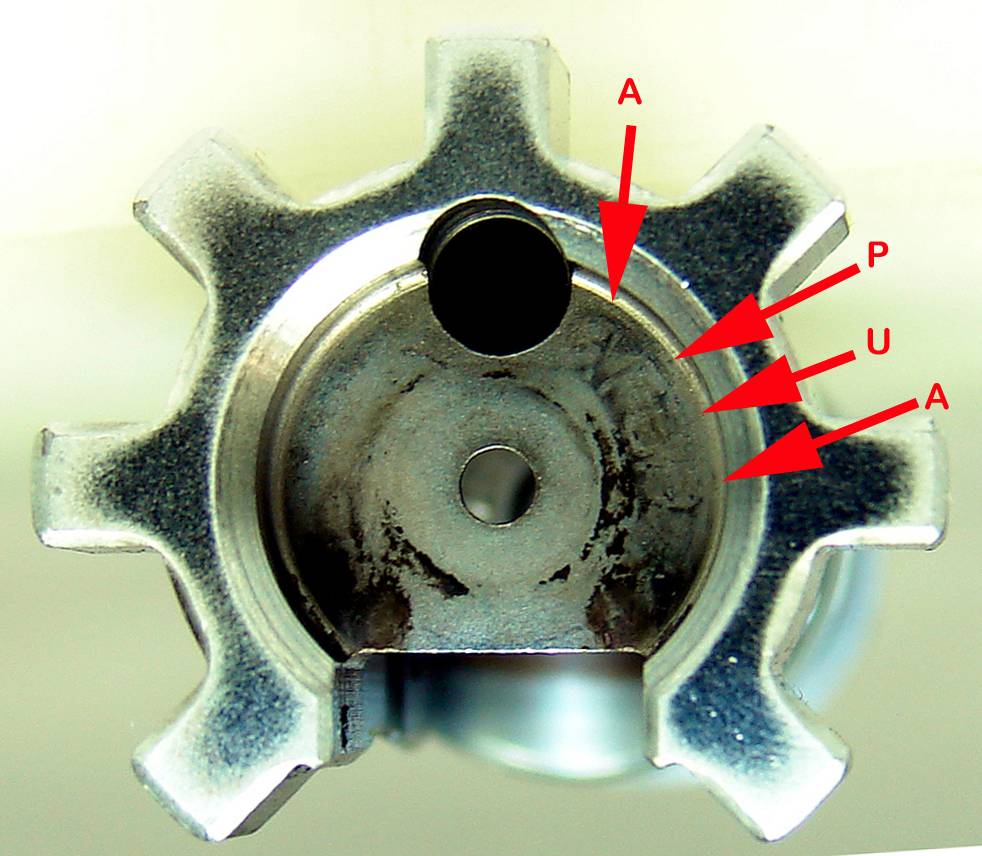
I flipped the image of the bolt for easier comparison to the blown case-head.
--------------------------------------------------------------------------------------------------------------------------------------------------------
As stated in my original post, I had to pound the bolt, carrier and fired case out of the barrel extension/upper receiver. The round did not fire out-of-battery.
The pic below shows the orientation of the locking-lugs on the barrel extension when the rifle is in the normal firing position. Note that the top locking-lug is exactly at the 12 o’clock position. You can also see that it is aligned with the index pin, which is at top-dead-center.
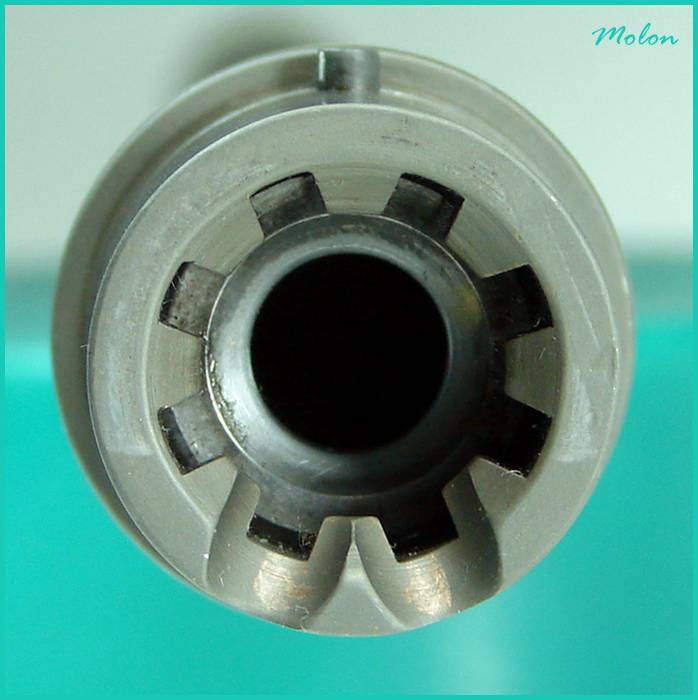
In the next pic, we see the orientation of the locking-lugs on the bolt when the bolt-carrier group has completely unlocked.
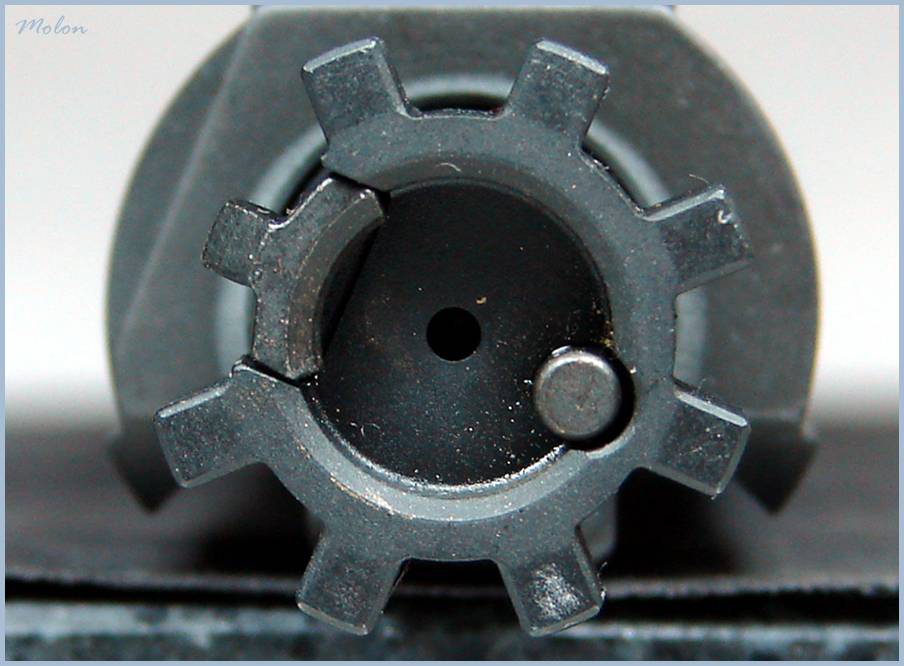
When the bolt has rotated completely into battery, the first locking-lug clockwise of the extractor (when looking directly at the bolt-face) will be in the 12 o’clock position. At this point it is physically impossible to have an out-of-battery discharge.

Now, let’s look at the position of the firing pin when the bolt has first rotated completely into battery. With the bolt still in the same position as in the picture above and completely in battery, you can push the firing pin as far forward as it will go (or hit it with the hammer or have the hammer follow the bolt into battery) and the firing pin will not have even started to protrude from the face of the bolt. It is physically impossible for the firing pin to come into contact with the primer before the bolt is completely in battery.
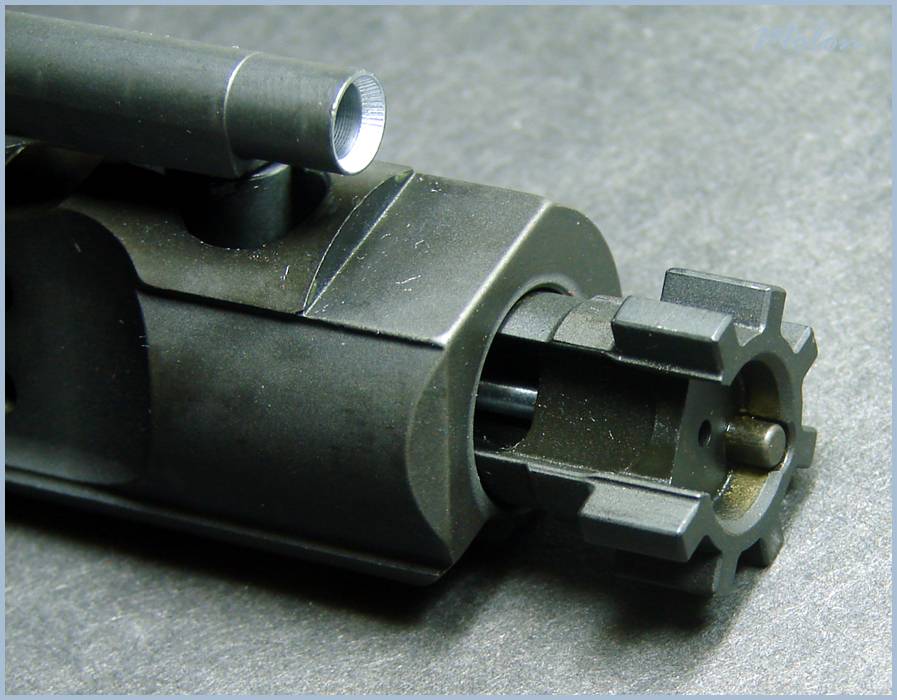
-------------------------------------------------------------------------------------------------------------------------------------------------------
…
This Krieger barrel has a 223 Remington chamber with a 1:9" twist. This barrel was purchased directly from Krieger Barrels, Inc. and was chambered by them. I've fired over a thousand trouble-free rounds through this barrel. The box label for this Berger ammunition clearly states that this is 223 Remington ammunition. Using a bullet pulled from this lot of ammunition, the cartridge overall length was 2.322" with this bullet seated to the lands of this barrel.
Shortly before shooting this Berger factory loaded ammunition, I fired a 10-shot group of factory loaded Sierra Prairie Enemy 55 grain BlitzKings. That group had an extreme spread of 0.72 MOA.
-----------------------------------------------------------------------------------------------------------------------------------------------------
----------------------------------------------------------------------------------------------------------------------------------------------------
No.
----------------------------------------------------------------------------------------------------------------------------------
This Berger factory loaded ammunition is loaded to magazine length. The longest rounds that I sampled are 2.262"; that's a jump of approximately 0.060" to the lands in this Krieger barrel.
-----------------------------------------------------------------------------------------------------------------------------------------------------------
Post #18.
The case neck does not extend into the throat of the chamber.
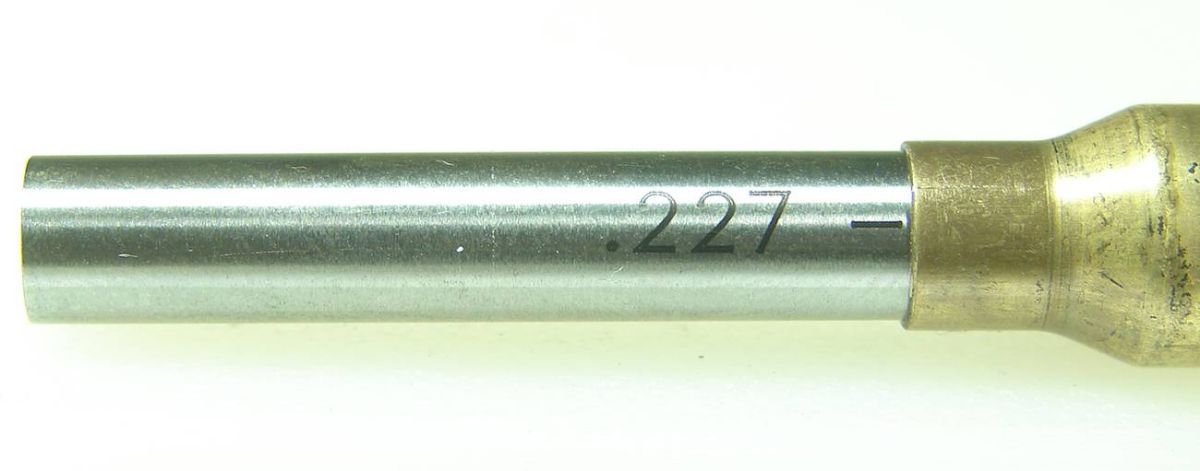
...
This barrel has a 1:9" twist.
------------------------------------------------------------------------------------------------------------------------------------
The fired case neck measured 0.254"
The unfired, factory loaded Berger rounds had neck diameters running 0.2505" to 0.252".
On numerous occasions.
------------------------------------------------------------------------------------------------------------------------------------
There is no carbon ring in this barrel.
See the measurements in post #22.
That's the plan.
------------------------------------------------------------------------------------------------------------------------------------------------------
No.
This is the first time I've used Berger factory loaded ammunition.
---------------------------------------------------------------------------------------------------------------------------------------------------------
Post #22
The fired case neck measured 0.254"
The unfired, factory loaded Berger rounds had neck diameters running 0.2505" to 0.252".
-------------------------------------------------------------------------------------------------------------------------------------------------------
Using a bullet pulled from this lot of ammunition, the cartridge overall length was 2.322" with this bullet seated to the lands of this barrel.
No.
No.
Negative.
----------------------------------------------------------------------------------------------------------------------------------------------------------
The Krieger barrel that this incident occurred with has a true 223 Remington chamber.
------------------------------------------------------------------------------------------------------------------------------------
223 Wylde chambers can safely fire 5.56mm pressure rounds.
----------------------------------------------------------------------------------------------------------------------------------
Update
Berger has reached out to me and offered to replace this ammunition. They also said ".We have had a couple of these reports. But it dosent seem an issue with all of this ammunition."
--------------------------------------------------------------------------------------------------------------------------
Update:
Berger is sending me a call-tag for the unfired rounds. Berger also stated, "there has been a change in this load between the lot that you have and the lot that we are sending you. The new load was developed in a standard SAAMI 223 Remington chamber."
----------------------------------------------------------------------------------------------------------------------------
.....
This is a safety warning pertaining to Berger’s factory loaded ammunition.
Berger 223 Remington
77 grain OTM Tactical
Part # 65-23030
Lot # P002745-1


While firing this ammunition from one of my Krieger barreled, semi-automatic, precision AR-15s, I experienced an uncharacteristic amount of recoil and muzzle blast. This occurred with the second round fired from the magazine and there were two bullet holes in the target, so there was no type of bore obstruction involved. (This AR-15 has functioned flawlessly for over one thousand rounds and has produced ½ MOA 10-shot groups at 100 yards.)
The action failed to cycle after firing this second round from the magazine and the trigger was dead. No amount pulling/pounding on the charging handle was able to free-up the bolt carrier group. As stated above, there were two bullet holes in the target so there was no type of bore instruction involved.
At home, I had to use a mallet and a Delrin rod to pound the bolt, carrier and case out of the barrel extension/upper receiver. Prior to pounding out the bolt carrier group, I took a quick look in the bore with a cheap borescope. It was clearly visible that the brass case (Lapua) was still tightly sealed to the walls of the chamber.

Upon examining the spent case, it was clearly visible that the primer pocket was greatly expanded and there was a large amount ejector and extractor brass-flow. The primer fell out of the bolt face when the case was removed with the pounding-out of the bolt carrier group.

The was a large “belt” of expanded brass just above the extractor groove. This belt had a diameter of 0.414” at the at the broadest section. The case was split on either side of the extractor brass flow. The case rim was split at the ejector brass flow.



I have not yet conducted a damage assessment of my AR15. A link to this thread has been sent to Berger and I’ll post their reply when I receive it. Until such time, I urge anyone who has also purchased this ammunition not to use it.
-----------------------------------------------------------------------------------------------------------------------------
This Krieger barrel has a 223 Remington chamber with a 1:9" twist. This barrel was purchased directly from Krieger Barrels, Inc. and was chambered by them. I've fired over a thousand trouble-free rounds through this barrel. The box label for this Berger ammunition clearly states that this is 223 Remington ammunition.
Using a bullet pulled from this lot of ammunition, I determined the cartridge overall length that would be necessary for the bullet to be seated to the lands of this barrel. That distance was 2.322" and since the factory loaded ammunition was loaded to magazine length, the bullet was nowhere near the lands of my barrel.

Shortly before shooting this Berger factory loaded ammunition, I fired a 10-shot group of factory loaded Sierra Prairie Enemy 55 grain BlitzKings. That group had an extreme spread of 0.72 MOA.


The blown case has a weight of 99.0 grains. The neck diameter of this case is 0.254”. The diameter of the “belt” above the extractor groove is 0.414” at the broadest section.
The diameter of the case rim across the extractor and ejector brass flow is 0.423” and the diameter of the case rim rotated to 90 degrees of that position is 0.382”. The primer pocket has a diameter of approximately 0.222” at the broadest section.
I pulled-down 20 of the unfired cartridges from this lot of ammunition. Here’s the compiled data.

You can see a larger view of the above data sheet here. (or just click on the pic above.)
Pulled-down powder from this Berger ammunition.

Pulled-down powder charge weights . . .

I pulled-down a couple more rounds after compiling the above data and found a round with a charge of 23.6 grains. The puts the powder charge variation at 1.8 grains.

28.6 grains of this pulled-down powder filled a randomly selected pulled-down case to the case mouth. The longest cartridge overall length that I measured from this lot of factory loaded ammunition was 2.262". I was able to load 26.0 grains of the pulled-down powder into a pulled-down case and seat a pulled-down bullet to a cartridge overall length of 2.262".
This ammunition is a heavily compressed load, so bullet set-back is highly improbable. Since it was a compressed load, I was unable to use my custom K&M compression gauge to obtain an accurate measure of neck tension, however, it required quite a bit of force to pull the bullets from the cases using a press-mounted, collet bullet-puller. Also, using the custom K&M compression gauge, I applied 90 pounds of force to one of the factory-loaded cartridges that had a cartridge overall length of 2.253". After applying the 90 pounds of force, I again measured the COAL. It was still 2.253".
Pulled-down case weights . . .

The case weights past the plus one standard deviation are the heaviest Lapua Match cases that I've ever seen. (Legacy"standard" Lapua cases did weigh more.)
Berger did eventually issue a "safety notice" for this ammo, but not until after I informed them that I was not going to return the defective ammo. That was four weeks after I informed them of the issue. The safety notice stated that this ammunition "may cause function/ignition issues with AR-style gas operating platforms" and that "bolt action rifles are not affected".
---------------------------------------------------------------------------------------------------------------------------------------------------------
Pressure Testing Update
We’ll never know what the powder charge weight was for the factory loaded round of Berger 77 grain OTM ammunition that blew-out in my AR-15. We do know for a fact that the weight of the case that blew-out was 99.0 grains. We can also be fairly certain that the weight of the bullet in that round was 77.0 grains, since all of the bullets that I pulled-down from that same lot of ammunition weighed 77.0 grains. We also know that primers from pulled-down rounds in that lot of ammunition had a nominal weight of 3.7 grains.
In addition, we know that Berger’s abysmal quality control resulted in powder charges for the sample of rounds that I pulled-down to range from 21.8 grains to 23.6 grains for this so-called “match grade” ammunition. That’s a spread of 1.8 grains in the powder charge and it’s quite likely that a larger sample size would have detected an even greater spread.

The mean powder charge weight for the small sample that I weighed was 22.41 grains. The standard deviation was 0.447 grains. The mean powder charge weight plus three standard deviations was 23.75 grains.
The pressure testing was conducted in the ballistic lab of one of the leading ammunition manufacturers in the United States. A 24” SAAMI spec 223 Remington pressure and velocity test barrel was used with a PCB conformal pressure sensor. The system was calibrated with SAAMI reference ammunition and additionally the pressure sensor was calibrated to unfired Lapua cases pulled-down from the Berger ammunition.
The SAAMI specification for the maximum average pressure for the 223 Remington cartridge is 55,000 PSI. Ten rounds of the Berger factory loaded 77 grain OTM ammunition were fired from the 223 Remington pressure test barrel. Obviously, we don’t know what the powder charges were for those ten rounds.
You may remember that in the last email that I sent to Mr Praslick (the one that he didn’t even have the common courtesy to reply to) I stated that it would have taken a pressure of over 70,000 PSI to cause such deformities to the cartridge case when fired from an AR-15. The first shot fired from the pressure test barrel had a pressure of 77,919 PSI. Shot #8 had a pressure of 78,369 PSI. That’s 23,369 PSI higher than the SAAMI MAP specification for the 223 Remington cartridge.
The data for all ten shots is summarized in the table below. This data shows that Berger failed miserably in their due diligence in developing and manufacturing this load and releasing this dangerous product for sale to the public.
The data also makes it painfully obvious that this was not a “cycling” issue for semi-automatic AR-15s and that Berger’s safety notice (the one that they didn’t even issue until a month after I informed them of this safety issue and that they didn’t issue until after I had notified them that I was not going to be returning the defective ammunition to them) claiming that this ammunition “may cause function/ignition issues with AR-style gas operating platforms. Bolt action rifles are not affected” was just a whitewashing of their lack of transparency in this matter.
Aside from the huge safety issue with this ammunition, the velocities from the test barrel had an extreme spread of 221 FPS with a standard deviation of 74 FPS. That is beyond pathetic for so-called “match grade” ammunition that cost $1.60 per round.

TTP = time to peak pressure
AT = time to the bullet exiting the muzzle
As I mentioned earlier, a powder charge weight of 23.6 grains was found in the small sample of rounds that I pulled-down and it’s likely that a heavier charge would have been found with a larger sample size. The average powder charge weight plus three standard deviations was 23.75 grains.
For additional testing I pulled-down several more rounds from this lot of the Berger factory loaded ammunition and re-charged those rounds with a powder charge weight of 23.7 grains of the pulled-down powder. The powder was dispensed using an RCBS Match Master powder dispenser. The Match Master dispenser has an advertised accuracy of 0.04 grains. The heaviest Lapua case (accounting for the weight of the primer) of these rounds weighed 97.0 grains.
I seated virgin Berger 77 grain OTM bullets (all of which weighed 77.0 grains) in the re-charged cases to a nominal COAL of 2.260” using a Forster Co-Ax press. Five of these re-charged rounds were fired from the same pressure test barrel described above.
Shot #2 had a pressure of 81,769 PSI. Shot #4 had a pressure of 83,544 PSI with a velocity of 3024 FPS. The results are summarized in the table below.

….
Could you post a full length photo of this case and an unfired case side by side?

--------------------------------------------------------------------------------------------------------------------------------------------------------------
@Molon
Can a bullet, and when pressing its tip against a firm surface be easily moved further into the case ?
No. This ammunition is a heavily compressed load, so bullet set-back is highly improbable. Since it was a compressed load, I was unable to use my custom K&M compression gauge to obtain an accurate measure of neck tension, however, it required quite a bit of force to pull the bullets from the cases using a press-mounted, collet bullet-puller. Also, using the custom K&M compression gauge, I applied 90 pounds of force to one of the factory-loaded cartridges that had a cartridge overall length of 2.253". After applying the 90 pounds of force, I again measured the COAL. It was still 2.253".
-----------------------------------------------------------------------------------------------------------------------------------------------------------
--------------------------------------------------------------------------------------------------------------------------------------------------------------
It takes well over 70,000psi to make lesser brass flow into the ejector pocket like that, as well as make the primer pocket go from a circular shape to an egg. Primers will often blow at 70ksi, but the case head might not have anywhere near that much eschar/soot.
I agree with 357max, that if this wasn’t Lapua brass, we’d be looking at case head separation and a blown ejector at a minimum.
My guess is that this was anywhere from 75-90ksi, maybe more.
How much pressure does it take for the letters on the case-head to engrave into the face of the bolt?

I flipped the image of the bolt for easier comparison to the blown case-head.
--------------------------------------------------------------------------------------------------------------------------------------------------------
Did the weapon fire out of battery?
that’s my guess.
As stated in my original post, I had to pound the bolt, carrier and fired case out of the barrel extension/upper receiver. The round did not fire out-of-battery.
The pic below shows the orientation of the locking-lugs on the barrel extension when the rifle is in the normal firing position. Note that the top locking-lug is exactly at the 12 o’clock position. You can also see that it is aligned with the index pin, which is at top-dead-center.

In the next pic, we see the orientation of the locking-lugs on the bolt when the bolt-carrier group has completely unlocked.

When the bolt has rotated completely into battery, the first locking-lug clockwise of the extractor (when looking directly at the bolt-face) will be in the 12 o’clock position. At this point it is physically impossible to have an out-of-battery discharge.

Now, let’s look at the position of the firing pin when the bolt has first rotated completely into battery. With the bolt still in the same position as in the picture above and completely in battery, you can push the firing pin as far forward as it will go (or hit it with the hammer or have the hammer follow the bolt into battery) and the firing pin will not have even started to protrude from the face of the bolt. It is physically impossible for the firing pin to come into contact with the primer before the bolt is completely in battery.

-------------------------------------------------------------------------------------------------------------------------------------------------------
…
What chamber is your Krieger?
This Krieger barrel has a 223 Remington chamber with a 1:9" twist. This barrel was purchased directly from Krieger Barrels, Inc. and was chambered by them. I've fired over a thousand trouble-free rounds through this barrel. The box label for this Berger ammunition clearly states that this is 223 Remington ammunition. Using a bullet pulled from this lot of ammunition, the cartridge overall length was 2.322" with this bullet seated to the lands of this barrel.
Shortly before shooting this Berger factory loaded ammunition, I fired a 10-shot group of factory loaded Sierra Prairie Enemy 55 grain BlitzKings. That group had an extreme spread of 0.72 MOA.
-----------------------------------------------------------------------------------------------------------------------------------------------------
Yup.What you're seeing with the belt is excessive pressure inside the case ballooning the web in the space between the bolt and breech face and chamber chamfer.
----------------------------------------------------------------------------------------------------------------------------------------------------
Did Berger ask for the blown case back to help with their investigation?
No.
----------------------------------------------------------------------------------------------------------------------------------
Aren't those bullets seated long or something?
This Berger factory loaded ammunition is loaded to magazine length. The longest rounds that I sampled are 2.262"; that's a jump of approximately 0.060" to the lands in this Krieger barrel.
-----------------------------------------------------------------------------------------------------------------------------------------------------------
I did not see any specs on barrel.
Post #18.
Thicker necks in a smaller/tighter throat would create pressure
The case neck does not extend into the throat of the chamber.
Try to drop a bullet back into a fired case, if you can. If a bullet does not drop free or with very little resistance into a fired case.....prob a part of the issue, along with it is a bit warm of a load to begin with.

...
2nd, a faster twist rate with heavier bullets can show pressure sooner.
This barrel has a 1:9" twist.
------------------------------------------------------------------------------------------------------------------------------------
What does the neck measure fired - unfired?
The fired case neck measured 0.254"
The unfired, factory loaded Berger rounds had neck diameters running 0.2505" to 0.252".
Have you shot Lapua through this Krieger before?
On numerous occasions.
------------------------------------------------------------------------------------------------------------------------------------
A little carbon ring would be magnified badly by the Lapua brass.
There is no carbon ring in this barrel.
. . . but I'd like to see tight neck fit ruled out.
See the measurements in post #22.
Assuming you'll be running the remaining unfired rounds across your scale to see if anything obvious shows up.
That's the plan.
------------------------------------------------------------------------------------------------------------------------------------------------------
Any chrono data on the Berger lot/ammo samples?
No.
How much Berger ammo have you previously put thru the rifle ?
This is the first time I've used Berger factory loaded ammunition.
---------------------------------------------------------------------------------------------------------------------------------------------------------
I still think you should look at barrel reamer specs vs loaded ammo. The PTG reamer spec for the neck is .252. Most Lapua and other high end brass is .015 on neck wall thickness. That equals a .254 loaded diameter (.015 neck x2 plus .224 bullet diameter). It should be a .250 loaded diameter for it to run right. I have seen this many times.
Post #22
The fired case neck measured 0.254"
The unfired, factory loaded Berger rounds had neck diameters running 0.2505" to 0.252".
-------------------------------------------------------------------------------------------------------------------------------------------------------
@Molon do you have a way to measure distance to the lands/jam in your rifle?
Using a bullet pulled from this lot of ammunition, the cartridge overall length was 2.322" with this bullet seated to the lands of this barrel.
.
Have you shot this particular load from Berger in this rifle before?
No.
and lastly, it’s now summer and hot, possible the box of ammo was sitting in the sun/trunk of a car before it went through the rifle?
No.
Do a bunch of shooting and let the runs sit in the chamber a while?
Negative.
----------------------------------------------------------------------------------------------------------------------------------------------------------
Yeah I have some of that lot too. It's all been completely fine in my 223 Wylde. Bolt gun. Both lots 1 and 3
The Krieger barrel that this incident occurred with has a true 223 Remington chamber.
------------------------------------------------------------------------------------------------------------------------------------
Hmmmm. Of course, the ammo is 223 Rem ammo. It isn't. "223wylde". So that's not an excuse, but Id think that figures into it. What do you think?
223 Wylde chambers can safely fire 5.56mm pressure rounds.
----------------------------------------------------------------------------------------------------------------------------------
Update
Berger has reached out to me and offered to replace this ammunition. They also said ".We have had a couple of these reports. But it dosent seem an issue with all of this ammunition."
--------------------------------------------------------------------------------------------------------------------------
Update:
Berger is sending me a call-tag for the unfired rounds. Berger also stated, "there has been a change in this load between the lot that you have and the lot that we are sending you. The new load was developed in a standard SAAMI 223 Remington chamber."
----------------------------------------------------------------------------------------------------------------------------
.....
Last edited:

